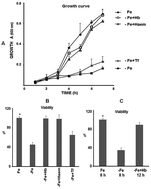Streptococcus pneumoniae requires iron for its viability and expresses two membrane proteins that bind haemoglobin and haem
Abstract
Streptococcus pneumoniae, a human pathogen bacterium, can support its growth using haemoglobin (Hb) and haem as sole iron sources, but not when holo-transferrin or holo-lactoferrin is supplied. For this reason, it is easy to think that the principal iron sources for this pathogen inside humans are Hb and haem. Unfortunately, the mechanism has been poorly studied. The findings presented in this study are the first efforts that attempted to explain the mechanism involved in iron acquisition of this pathogen. This pathogen was capable of supporting its viability when iron sources such as Hb or haem were supplied. Membranes of S. pneumoniae were separated and their respective

- This article is part of the themed collection: Microbial Metallomics

 Please wait while we load your content...
Please wait while we load your content...